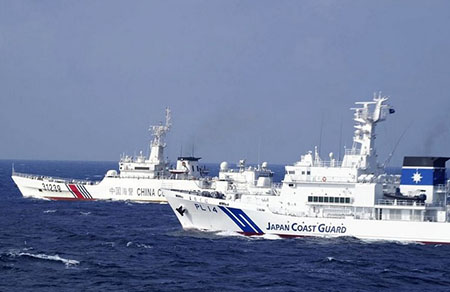by WorldTribune Staff, June 4, 2021
China’s Coast Guard, which is now under the direct command of the PLAN (People’s Liberation Army Navy), sent four ships into Japan’s contiguous zones off the Senkaku Islands on Thursday, the Japanese Coast Guard reported.
It marked the 112th consecutive day communist China sent its vessels near the islands in Okinawa Prefecture.

“This is an extremely serious situation. We have always deployed more patrol vessels than the other side, taking all possible measures to keep guard,” Japanese Chief Cabinet Secretary Katsunobu Kato said at a Thursday press conference.
Related: Did Team Biden’s equivocation on Senkakus signal weakness?, March 2, 2021
The Japan Coast Guard has 12 patrol vessels with the duty of monitoring China Coast Guard vessels and protecting Japanese fishing ships.
Since coming under the PLAN’s command, the China Coast Guard now has the capability of using weapons capable of sinking fishing vessels.
“At the same time, the Japan Coast Guard remains part of the Japan Police Department and not part of the Japan Self Defense Force (JSDF), the military arm of the Japanese government,” analyst Ryo Saito noted.
Contiguous zones extend 12 nautical miles (about 22 kilometers) beyond territorial waters, which are the area within 12 nautical miles of the coast. Although foreign vessels are allowed to sail in the zones freely, the coastal state is given certain types of authority such as exercising measures to prevent criminal activities.
“The frequency of China Coast Guard vessels entering the contiguous zones increased sharply after Japan nationalized the Senkaku Islands in 2012, becoming an almost regular occurrence from around 2019,” The Yomiuri Shimbun reported.
In a late February incident, a fishing ship of a 60-year-old Japanese fisherman from Miyakojima, Okinawa Prefecture, was followed by two China Coast Guard vessels in territorial waters near Taisho Island. “Two coast guard vessels were following our fishing ship as if they were trying to pincer us. We even feared they might hit us,” the fisherman said. He said the Chinese vessels had been watching his fishing ship from the contiguous zone.
On May 28 and 29, Channel Sakura TV aired a live stream (see below) of the fishing activities near the Senkaku Islands, issuing the following statement:
“This is a live report of the fishing activities of Ishigakijima fishing boats, Daiichi Sakuramaru, Emimaru, and ZENKOUMARU2 in the territorial waters of the Senkaku Islands from May 28th to 29th.”
From the live stream, Saito noted, “it is clear that the China Coast Guard has taken control of the Senkaku area.”
“Despite warnings from the Japanese Coast Guard, these courageous fishermen from Ishigakijima decided to push the envelope further to expose the Japan Coast Guard’s appeasement-like policy against Chinese bullying and aggression, which has been particularly getting serious concerns along with Taiwan, Philippines, Vietnam, and other southeast Asian countries who are abiding by the international navigation treaties,” Saito noted.
“Eyeing his re-election in 2022, Xi Jinping wants to dismiss Japan of effective control of the Senkakus by any means possible for China to control half of the Pacific, thus enabling China to be the maritime superpower,” Saito added.
The Chinese government in February revised a law which ensures other countries’ right of innocent passage through territorial seas, which is stipulated in the United Nations Convention on the Law of the Sea. The new law from Beijing says the UN law may not be respected in China’s territorial waters.
“It does not specify areas covered by the law; instead, it simply states that it covers the waters under China’s jurisdiction,” the Yomiuri Shimbun noted.
After World War II, under the San Francisco Peace Treaty, the Senkaku Islands came under the administration of the United States as part of Okinawa, thereby reaffirming the islands’ status as part of Japanese territory.
In 1972, according to the Okinawa Reversion Agreement between the United States and Japan, the administrative rights of Okinawa, which includes the Senkaku Islands, were returned to Japan from the United States.
INFORMATION WORLD WAR: How We Win . . . . Executive Intelligence Brief
